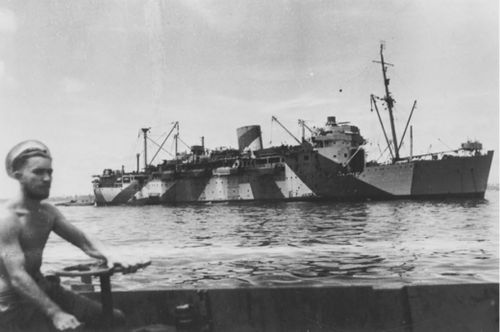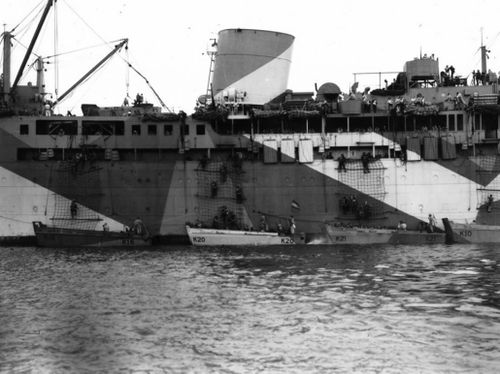Difference between revisions of "HMAS Kanimbla"
From Our Contribution
| Line 1: | Line 1: | ||
{{Infobox ship | {{Infobox ship | ||
| − | | image = [[File:HMAS_Kanimbla.jpg]] | + | | image = [[File:HMAS_Kanimbla.jpg|500px]] |
| caption = http://www.navy.gov.au/hmas-kanimbla-i accessed 11 Sep 2019 | | caption = http://www.navy.gov.au/hmas-kanimbla-i accessed 11 Sep 2019 | ||
| − | | image2 = [[File:HMAS Kanimbla_2.jpg]] | + | | image2 = [[File:HMAS Kanimbla_2.jpg|500px]] |
| caption2 = http://www.navy.gov.au/hmas-kanimbla-i accessed 11 Sep 2019 | | caption2 = http://www.navy.gov.au/hmas-kanimbla-i accessed 11 Sep 2019 | ||
| shipname = HMAS Kanimbla | | shipname = HMAS Kanimbla | ||
Revision as of 02:39, 12 September 2019
 http://www.navy.gov.au/hmas-kanimbla-i accessed 11 Sep 2019 | |
 http://www.navy.gov.au/hmas-kanimbla-i accessed 11 Sep 2019 | |
| History | |
|---|---|
| Name | HMAS Kanimbla |
| Owner | McIllwraith McEachern Ltd |
| Builder | Harland & Wolff, Belfast |
| Launched | 15 Dec 1935 |
| Completed | May 1936 |
| In service | May 1936 |
| Out of service | 25 Mar 1959 |
| Fate | sold to Taiwan for scrap in 1973 |
| General characteristics | |
| Tonnage | 10,985 tons |
| Length | 468.8 feet (142.89m) |
| Beam | 66.3 feet (20.21m) |
| Depth | 24.4 feet (7.44m) |
| Propulsion | diesel twin screws 10,000 HP |
| Speed | 19 knots |
| Capacity | Crew of 345 and 1,280 troops as a LSI |
Remarks
Operating a passenger service between Cairns and Fremantle, she was requisitioned on 5 Sep 1939 and converted to an Armed Merchant Cruiser. Shewas commissioned into the Australian Navy on 6 Oct 1939. On 13 Dec 193 she departed Sydney for Hong Kong where she patrolled the Chinese and Japanese coasts looking for ships belonging to countries that were at war with Australia or had been taken over by the Germans and Italians. She was able to capture 10 Norwegian ships and one Dutch ship of the Chinese coast and sent them to Hong Kong.
In June 1940 she was repositioned to operate out of Singapore, patrolling the Malay and East Indies coast lines. On 24 Aug 1941, with 300 Indian troops aboard she entered the Iranian port of Bandar Shahpur, capturing eight German and Italian merchant ships with valuable cargoes, plus two Iranian gunboats and a floating dock. Further patrol work followed before she escorted the first convoy to flee Singapore after the Japanese attack on Malaya to Melbourne.
On 2 Feb 1943 the Kanimbla arrive in Sydney for conversion to a Landing Ship Infantry, with work completed by 1 Jun 1943 when she was recommissioned. the rest of 1943 was spent in Australian waters before she became involved in exercises to prepare for landing on Pacific islands. The first landing she was involved with was at Hollandia in Dutch New Guinea. This was followed by landings at Morotai, Leyte Gulf, Lingayen (Luzon Island). Following transport tasks in New Guinea theatre of war she returned to Sydney on 7 Mar 1945.
The Kanimbla returned to participate in the invasion of Brunei in June and the landings at Balikpapan in early July 1945. At the completion of hostilities, the Kanimbla was used to repatriate Australian servicemen, and return Dutch civilians to the East Indian islands. Several voyages between Sydney and Japan followed to transport our Occupying troops and their stores between October 1946 and June 1948. One last voyage to Japan was followed by decommissioning on 25 Mar 1949. Once refitted she was returned to her owners on 13 Dec 1950 who operated her until selling her in 1961 to the Pacific Transport Company. Renamed Oriental Queen she spent the next three years transporting pilgrims to Jeddah from Jakarta.
Chartered and later purchased by a Japanese shipping company, she operated between Guam and Yokohama until 1973 when he was sold for scrap.
Battle Honours
- Pacific 1941-45
- New Guinea 1942-45
- Leyte Gulf 1944
- Borneo 1945
- Lingayen Gulf 1945
Crew Members
- Gavin Stirling Blackwood 26 January 1943 - October 1945